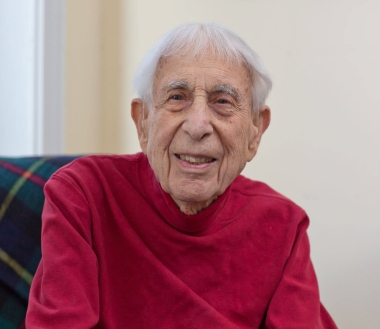“All of the staff deserve great credit. My doctors worked together beautifully as a team so I feel I am in excellent hands.”

As a World War II British Intelligence officer, a celebrated photographer and author of more than 10 books, it’s safe to say that Jon has lived a full life.
But even now, with his 97th birthday quickly approaching, the Trenton resident still feels he has more to do.
“I want to offer the world the chance to share with me some of the things I’ve been lucky enough to see,” Jon says.
He has seen quite a bit. Though he never planned to be a professional photographer, Jon’s talents led him to see a number of things through his camera lens – including the dazzling light from a Mexico City sky, the underappreciated fine art of graffiti, and even a portrait of a young Andy Warhol.
He has also seen cancer.
In April of 2016, a routine X-ray for back pain revealed that Jon had lung cancer. Having already waged successful battles with prostate and gastrointestinal cancer nearly 10 years prior, Jon prepared to meet this challenge with the same perseverance he had before.
But this time, now in his late 90s, he would need a unique kind of care.
Cancer in the Elderly
More than 60 percent of cancers in the United States occur in patients over the age of 65. To most people, age is just a number. But when it comes to cancer, treating a patient in their 70s, 80s or 90s is much different than treating a patient in their 30s.
Older patients are often also managing with chronic conditions like diabetes or high blood pressure. Their bodies may also not heal as quickly or as well following surgery or intense treatment, thus limiting the ways in which their cancer can be treated.
“To most people age is just a number,” says Rachana Singh, MD, a radiation oncologist with the Rutgers Cancer Institute of New Jersey (CINJ) at RWJ Hamilton. “But when you have someone who is almost a centenarian, you don’t want their treatment to send them over the edge and make them ill.”
A Unique Plan of Care
Jon successfully battled prostate cancer in 2005 and a gastrointestinal stromal tumor in 2007. For the stromal tumor, he had surgery done at the Rutgers CINJ in New Brunswick and then was able to receive chemotherapy in Rutgers CINJ in Hamilton where he could be close to his primary care physician, cardiologist and his home.
So it only made sense that Jon would return to Hamilton to treat his lung cancer.
Due to Jon’s his age, his medical history and the tumor’s location near his spine, surgery and chemotherapy were not an option. That’s when he met Dr. Singh. Working closely with Jon and his other providers, she helped tailor a radiation treatment plan that would be effective, but not too strenuous.
Jon received a six-and-a-half week course of radiation treatment that was divided up into 34 moderate doses so it was easier for his body to handle.
“We were actually willing to stop at about 25 doses but he was doing so well that we suggested that we push through it and he was all for it,” Singh said.
Jon’s treatment ended in December. Scans showed that his tumor had shrunk significantly, as had the back and shoulder pain that had led to the discovery of the tumor.
“All of the staff deserve great credit,” Jon says. “My doctors worked together beautifully as a team so I feel I am in excellent hands.”
Preserving a Legacy
Today Jon continues to write and take photographs. He recently completed a memoir of his wartime experience and is compiling his photographic work into archives to better share with future photographers.
Those future photographers include his own son and young grandson who is already using a camera of his own and may one day follow in his grandfather’s footsteps.
“My work is something I’ve always wanted to share with the next generation,” Jon says. “Now with my grandson I have two generations to share with.”